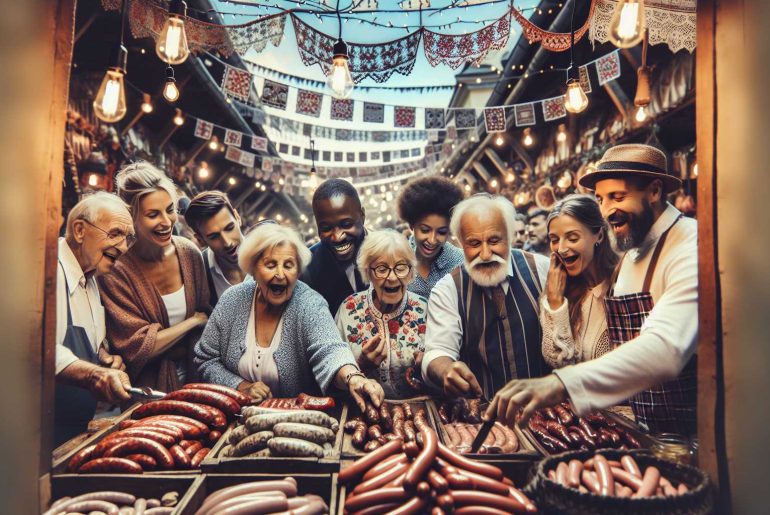
Poland has a deep connection with sausage, and it’s not just about the flavor. This love for sausage goes way back and is tied to the country’s history, culture, and traditions. From the popular kielbasa to the many unique types found across the country, sausage is a key part of Poland’s food scene.
It’s more than just food; it’s a symbol of Polish identity. Let’s dive into why sausage holds such a special place in Poland, from its historical roots to the craftsmanship involved in making it, and its role in Polish celebrations and current trends. It’s fascinating to see how this simple food item has become so central to what it means to be Polish.
Historical Roots of Sausage
Poland’s tradition of making sausages dates back to ancient times, reflecting its rich cultural heritage. Over the centuries, this tradition has grown and changed, influenced by Poland’s social and economic conditions, as well as its interactions with other cultures.
Initially, Polish sausages were mostly made from pork, a choice that was closely linked to the country’s farming practices and what people preferred to eat back then. The methods used to prepare sausages were largely driven by the need to preserve meat. This led to the creation of smoked and cured sausages, perfect for surviving the cold Eastern European winters. These preservation techniques did more than just make the meat last longer; they gave Polish sausages their unique tastes, which are now celebrated features of Poland’s culinary identity.
Making sausage in Poland was more than just cooking; it was an art that showed how geography, climate, and cultural interactions could influence food. For example, the technique of smoking sausages not only helped in preserving them but also added a depth of flavor that is cherished in Polish cuisine today. This process involves hanging sausages in a smokehouse where they absorb the smoky aroma from burning woods, creating a flavor profile that’s distinctly Polish.
Let’s take a closer look at a popular Polish sausage: the Kielbasa. This sausage is a staple in Polish cuisine and comes in various forms, each with its own recipe and preparation method. Whether it’s served in a stew, sliced on a charcuterie board, or simply grilled, Kielbasa showcases the versatility and richness of Polish sausage-making traditions. Its popularity also highlights how traditional foods can remain central to a nation’s cuisine, even as tastes and techniques continue to evolve.
Regional Varieties Unveiled
In Poland, the variety of sausages tells a story about each region’s history, geography, and way of life. For example, Kielbasa Krakowska, known for its bold garlic flavor, reflects Krakow’s rich culinary history. In contrast, Kielbasa Lisiecka, flavored with juniper, comes from Lesser Poland, an area known for its forests. This choice of ingredients points to the locals’ use of what’s available in their natural surroundings, including herbs and game.
Another interesting variety is Kielbasa Ziebicka from the Podhale region, which stands out because it’s made with sheep’s meat. This choice highlights the region’s sheep farming tradition. Each of these sausages not only brings a unique taste to the table but also tells us about the people and the landscapes of Poland.
By exploring these regional specialties, we get a glimpse into how Poland’s diverse natural resources, historical movements, and creative culinary practices have all played a role in shaping the country’s sausage traditions. This journey through Poland’s sausages isn’t just about tasting different flavors. It’s also an exploration of the country’s cultural mosaic, where each region contributes its own chapter to the story.
If you’re curious about Polish cuisine, trying these sausages can be a great start. Each one offers a unique taste experience that reflects its region’s character and traditions. Through these flavors, you can begin to appreciate the diversity and richness of Poland’s culinary heritage.
The Art of Sausage Making
Let’s dive into the fascinating world of sausage making in Poland, an art form that has been perfected over centuries. This isn’t just about cooking; it’s a craft that combines precision, tradition, and a bit of science. The journey begins with selecting the right meats. Typically, this includes pork, beef, and sometimes veal. Each type of meat brings its own unique flavor and texture to the table, creating a delicious blend.
In Poland, the magic happens when artisans mix these meats with a special blend of spices, garlic, and herbs. The exact recipe changes from one region to another, reflecting the local culture and taste preferences. For example, in the mountainous regions, you might find sausages with a hint of smokiness, while coastal areas might have recipes that include fish or seafood.
Once the meat and spices are thoroughly mixed, it’s time to stuff this mixture into casings. These can be either natural, made from the intestines of animals, or synthetic. This step requires a steady hand and an eye for detail to ensure each sausage is perfectly shaped.
Next comes the flavoring process, which can involve smoking, drying, or boiling. Each method adds its own unique taste and helps preserve the sausage. Smoking, for instance, gives sausages a rich, deep flavor and an appealing golden color. Drying, on the other hand, concentrates the flavors and extends the shelf life, making these sausages perfect for storing.
Through each step of this process, you can see the dedication and care that Polish artisans put into their craft. It’s not just about making food; it’s about preserving a piece of their cultural heritage and sharing it with the world.
For those interested in trying this at home, start simple. Look for a beginner’s sausage making kit online. These kits usually come with everything you need, including spices, casings, and detailed instructions. It’s a great way to get a taste of this rich culinary tradition and maybe even start a new hobby.
Sausage in Polish Celebrations
Sausages are central to Polish celebrations, playing a key role in their cultural traditions. They’re not just about taste; they symbolize community, heritage, and the passing of traditions from one generation to the next. In Poland, whether it’s a family event, a religious celebration, or a national holiday, sausages are a must-have on the menu. Each type of sausage has its own unique story, spices, and way of being made, which showcases the deep respect for culinary traditions in Polish culture.
For example, during Christmas, Poles enjoy ‘kabanosy’, a thin, smoked sausage that is flavorful and has a long history in Polish cuisine. Easter might feature ‘biala kielbasa’, a white sausage that is boiled and often served with horseradish. These are not just random choices; they reflect a careful preservation of family recipes and methods that have been handed down through generations.
The process of making these sausages involves selecting the right meats and spices, which is a skill in itself. This care in preparation highlights how sausages are more than food; they’re a connection to Polish identity and history. They embody the memories and shared experiences of many generations.
In a nutshell, sausages in Polish celebrations are a vivid example of how food can be a powerful symbol of culture and tradition. They bring people together, reminding them of their shared heritage and offering a taste of Poland’s rich culinary landscape. Whether you’re in Poland or somewhere else in the world, trying these sausages can give you a glimpse into the heart of Polish celebrations.
Modern Sausage Trends
Exploring the latest trends in sausage making reveals how Polish cuisine is evolving. Chefs and food producers are finding creative ways to blend tradition with innovation. This shift is largely driven by what consumers are now looking for – quality craftsmanship and responsibly sourced ingredients. For example, many artisan sausage makers are turning to local, sometimes organic, ingredients to craft sausages. These aren’t just any sausages; they’re ones that respect age-old recipes while introducing new flavors that today’s food lovers crave.
Let’s talk about the health trend, which is huge right now. People in Poland, like elsewhere, are paying more attention to what they eat. This means there’s a growing demand for sausages that are lighter in fat and even plant-based options. It’s not just about cutting calories; it’s about finding healthier ways to enjoy traditional foods. Some local brands are leading the way by offering sausages made from lean cuts of meat or entirely from plants, without sacrificing the taste that people expect from a good sausage.
But what does all this mean for the average sausage lover? It means a lot more variety and the opportunity to try sausages that are both delicious and better for you. Whether it’s a traditional pork sausage made with organic meat or a new, plant-based version that’s indistinguishable from the real thing, there’s something for everyone. Brands like Beyond Meat and Impossible Foods are making waves internationally with their plant-based sausages, and similar innovations are happening in Poland too.
Conclusion
Sausage holds a special place in Poland, with a deep-rooted history and a variety that changes from one region to another. Making sausage is an art form here, and it plays a key role in Polish celebrations, showing just how important it is in Polish culture.
As we look at current trends, it’s clear that this tradition isn’t just sticking around—it’s evolving, proving it’s still relevant today. So, when we talk about the Polish love for sausage, we’re really talking about a mix of history, local flavors, and cultural pride. It’s a topic that definitely deserves more exploration.







Comments are closed.